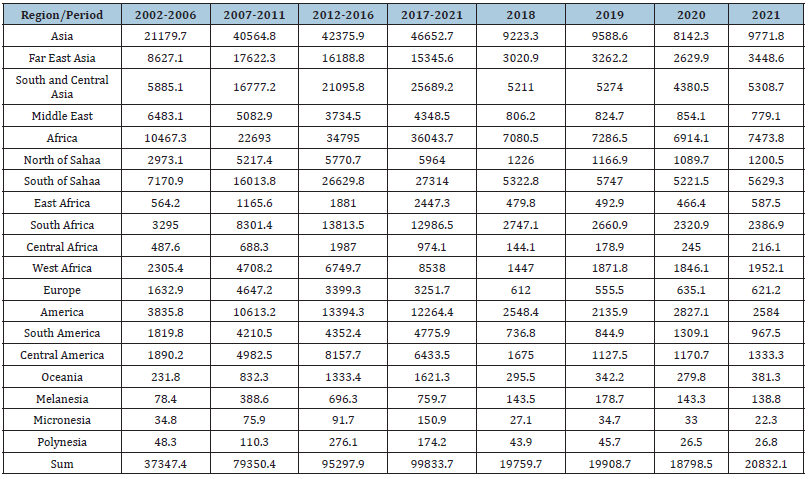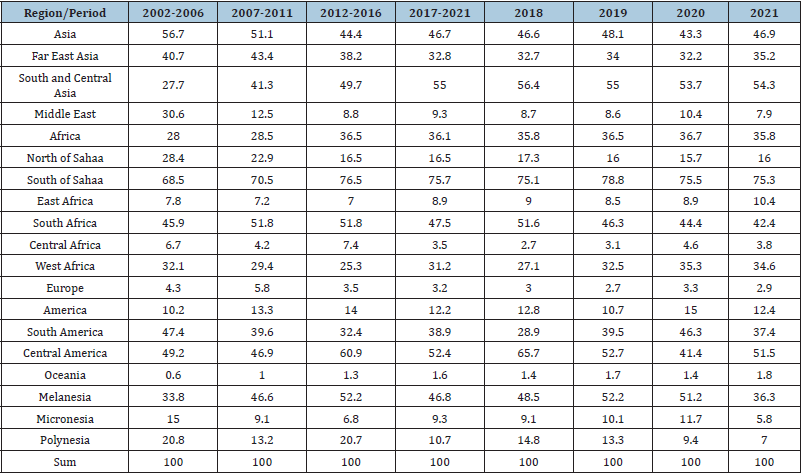- Submissions

Full Text
Progress in Petrochemical Science
Comparison of DAC’s Green Growth ODA Status by Region
Sang Soo Chae*
Department of Economics and Statistics, Korea University, South Korea
*Corresponding author:Sang Soo Chae, Department of Economics and Statistics, Korea University, South Korea
Submission: December 01, 2023;Published: December 14, 2023

ISSN 2637-8035Volume6 Issue1
Opinion
Recently, the world economy has been focusing on the possibility of a prolonged general recession. In addition, discussions on various paradigms and policies to sustain economic development continue. This discussion on economic development changes depending on various environmental factors and as the policy paradigm changes, the method of economic development in individual countries or regions changes. The main keywords of this paradigm are issues such as economic growth, sustainable development, social security and eco-friendliness, which are gaining attention and having a significant impact on policy decisions in major countries. Among the major issues of economic development, there is a long-term plan for sustainable development and various policies to realize it are being implemented in detail. The recent global economy has faced some limitations in existing policies for sustainable development, necessitating the application of a new paradigm. To this end, the world has focused on the two goals of environmental factors and economic growth and discussions on eco-friendliness, green growth, green economy, development aid, shared growth and social economy are becoming active as new convergence policies for this purpose. According to these environmental factors, the green growth ODA covered in this study has important implications. We consider eco-friendliness and green growth as an improvement direction in response to recent limitations in global economic growth. Green growth focuses on taking one step further to overcome the limitations of economic growth by considering eco-friendly factors and reducing environmental costs accordingly. In addition, development aid helps overcome these limitations in economic growth. In general, donor countries are made up of relatively developed countries and recipient countries are made up of relatively poor countries. Therefore, in addition to the redistribution effect of resources, economic effects that occur during the process can also be expected.
First, the concept of green ODA must first be discussed with regard to the Sustainable Development Goals. The Sustainable Development Goals (SDGs) are a plan proposed by the United Nations Environment Program (UNEP) under the United Nations (UN) and began with discussions on the global Our Common Future. Table 1 contains the 17 detailed items of the Sustainable Development Goals (SDGs). Five items can be divided into ‘people’, ‘global environment’, ‘economic prosperity’, ‘peace’ and ‘partnership’. Under these classification criteria, the importance of the ‘global environment’ section of the Sustainable Development Goals (SDGs) is becoming more important and the contents classified based on this category can be viewed as ‘green ODA’ items. Table 21 shows the status of green growth ODA implementation by region in DAC countries. It can be seen that the total ODA amount is continuously increasing on a DAC country-wide basis. From 2002 to 2006, approximately $37.3 billion worth of ODA was carried out and from 2007 to 2011, the size increased significantly, reaching approximately $79.3 billion worth of ODA. This increase in the size of ODA increased to $99.8 billion between 2017 and 2021, showing that the size of ODA related to green growth has been rapidly increasing since the mid-2000s. Looking at the proportion of DAC’s total green growth ODA, it is as follows. As of 2002-2006, the Asian region accounted for 47.4%. However, as of 2017-2021, it can be seen that it has slightly decreased to 46.7%. In addition, based on the most recent single year, the size of green growth ODA to the Greater Asia region remains flat at 46.9% in 2021.
Table 1:Sustainable development goals.

Source: UN (2016).
Table 2:Green growth ODA status by DAC recipient country region.

Note: ODA: Official Development Assistance; CRS: Creditor Reporting System
Meanwhile, the South and Central Asia region in the Cebu Asia region shows a relatively high proportion of 54.3%, showing that support for green growth has been relatively high. In the case of Africa, it accounts for the second highest share of green growth ODA at approximately 36.5%. The proportion is gradually increasing, showing a trend of increasing to 28.0% from 2002-2006 and 36.1% from 2017-2021. On the other hand, if you look at the recent singleyear standard, you can see that the proportion remains at the 35% level. Meanwhile, in the case of Oceania, it is above the 1% level, and it can be seen that a rather high proportion of green growth ODA was carried out at 1.8% in 2021. Table 3 shows the ODA status by region in DAC countries. It can be seen that the total ODA amount is continuously increasing on a DAC country-wide basis. Between 2002 and 2006, approximately $1.4 billion in ODA was provided and between 2007 and 2011, the size increased significantly, reaching approximately $6.6 billion. This increase in ODA amounted to $12.4 billion between 2017 and 2021, showing that the size of ODA related to green growth has been rapidly increasing since the mid-2000s. Looking at the recent ODA scale by single year, we can see that the size of ODA for green growth has increased from about $1.9 billion in ODA in 2018 to more than $3 billion since 2020, and donor countries related to green growth have increased since 2020. It can be seen that interest has increased further.
Table 3:Share of green growth ODA by DAC recipient country region.

Note:ODA: Official Development Assistance; CRS: Creditor Reporting System
© 2023 Sang Soo Chae. This is an open access article distributed under the terms of the Creative Commons Attribution License , which permits unrestricted use, distribution, and build upon your work non-commercially.
 a Creative Commons Attribution 4.0 International License. Based on a work at www.crimsonpublishers.com.
Best viewed in
a Creative Commons Attribution 4.0 International License. Based on a work at www.crimsonpublishers.com.
Best viewed in 







.jpg)






























 Editorial Board Registrations
Editorial Board Registrations Submit your Article
Submit your Article Refer a Friend
Refer a Friend Advertise With Us
Advertise With Us
.jpg)






.jpg)














.bmp)
.jpg)
.png)
.jpg)










.jpg)






.png)

.png)



.png)






